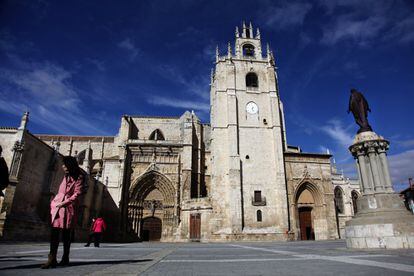The police believe they have clarified who stole the oldest map of the Caribbean kept in the Palencia cathedral for five centuries and whose disappearance was detected in 2019. The suspect would be a Spanish citizen with no criminal record, but who "fits the profile," according to sources. police.
To reach him, the agents of the Historical Heritage Brigade of the National Police opened three lines of investigation.
For one thing, a tip-off in Belgium led them straight to an “identical map” that was for sale in the United States, but was not the one they were looking for.
On the other hand, they collected statements from "all the people who were close to the stolen document in recent years" and, finally, they followed the trail of the map that the thief left instead of the original to delay the alarms from going off.
The Burgos Prosecutor's Office confirms that it is waiting to receive the report from the agents to take "the appropriate actions."
The arrest of the suspect may take place in the coming days.
The missing map is the work of the diplomat and historian Pedro Mártir de Anglería and the royal cartographer Juan Rodríguez de Fonseca.
In 1514, to facilitate the Crown's discovery of the Atlantic lands ―Christopher Columbus was reluctant to contribute his findings―, they agreed to draw the first map of the Caribbean with the information that other Spanish explorers in the area were contributing.
This is how they traced what is considered "a jewel of incalculable value", where the Gulf of Mexico, the north of South America, the entire Caribbean, the Canary Islands and even the Strait of Gibraltar were represented.
To draw it, both Spanish and Portuguese cartography was used, sent by Américo Vespucio.
When the work was finished, Anglería and Fonseca handed it over to an engraver, who carved it in boxwood to make other copies for the Crown.
Later, the map was included as an image in the book
Legatio Babilonica
and was kept in the cathedral of Palencia.
In 2019, the Burgos Cathedral opened an exhibition called
Burgos.
Zero league of the Magellan-Elcano voyage
,
which paid tribute to the first circumambulation of the planet completed in 1522 by only 18 of the 239 men who started it.
It was planned that in this exhibition the historical document would be exhibited within the
Legatio Babilonica
, but the map never reached the Burgos capital, as it had been replaced by another.
When and where was it stolen?
More information
The mysterious theft and forgery of the first map of the Caribbean
The first clue came from Belgium, where an expert believed he had found the map at an auction in California.
The Spanish experts analyzed the images of that geographical map, but determined that it was not the one they were looking for, but that it was an identical one, also of undetermined origin.
“It was not the map of Palencia, because in the one stolen in Spain ink stains can be seen that come from the opposite page of the book [
Legatio Babilonica
], while the copy auctioned in the United States is clean, without any stain,” sources point out. specialized in cartography.
“The curious thing is that this American map could also have been stolen, but it is not known from where.
The Spanish police have passed the information to the American police for investigation”, they point out.
Exterior view of the cathedral of San Antolín, in Palencia, where the first map of the Caribbean was kept.Santi Burgos
The second line of investigation that the agents followed comes from the map with which the thief replaced the original.
When the curator of the Burgos exhibition, Adelaida Segarra, opened the book in 2019, the map of Fonseca and Anglería was not found, as she expected, but another that showed the Río de la Plata region (Argentina) and where it was reproduced in detail the rivers of the Paraná.
This letter, whose antiquity has not transpired, but which is not current, "has been key to determining the possible author," say sources of the investigation.
“The map of the Río de la Plata has been subjected to all kinds of analysis, with crucial results.
There are always traces...”, they say.
Finally, the case has been clarified after the statements "of all the people who were close to the map in recent years."
For this reason, ecclesial sources familiar with the case assure that the cartographic document did not disappear during its transfer to Burgos, but in the cathedral of Palencia.
The dean of the cathedral archive of Palencia, Ángel de la Torre, told
El Norte de Castilla
last October, after announcing EL PAÍS the theft, that "he had never been aware that the document had disappeared until the judicial experts appeared in the cathedral to request the volume and the records of the people who in recent years have been able to have access to the book”.
The dean also pointed out that the
Legatio Babylonia
had only left the library of the Palencia cathedral for its exhibition in the Burgos seo in 2019 and "that no researcher had requested access to its pages, at least since 2011", when he himself was appointed archivist.
The police have already questioned "everyone" and are sure to know who took the cartographic jewel and when it was stolen.
Meanwhile, the Burgos Prosecutor's Office hopes to reopen the 95/19 investigation proceedings and be able to close the case of the theft of the first map of the Caribbean.
Now it remains to be found.

